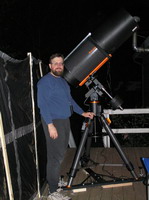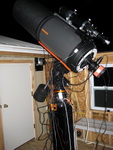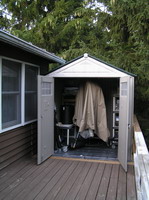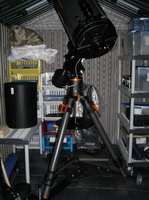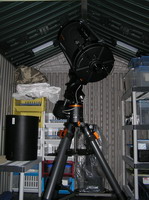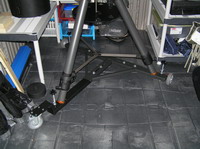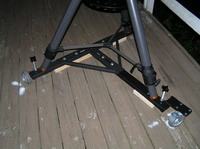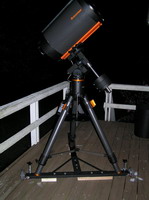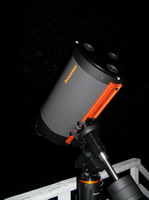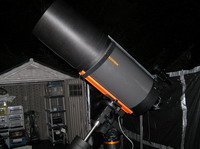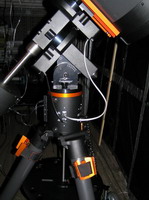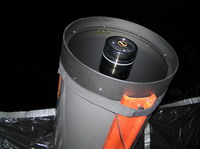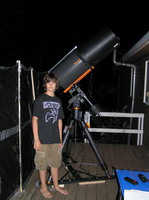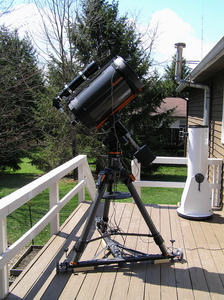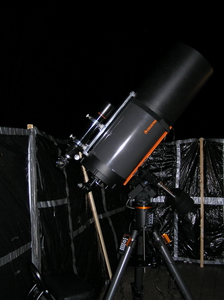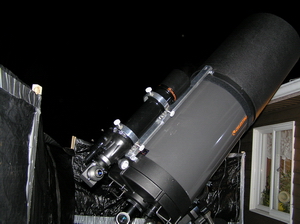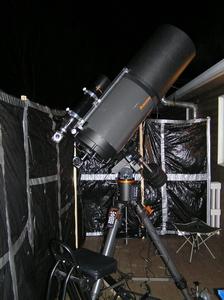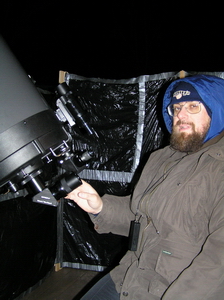Telescopes
Celestron CGE1400 XLT Fastar SCT
CGE1400 is an extremely versatile telescope, capable of high-magnification imaging at f11 or f8.8, wide field imaging with Hyperstar, electronically assisted observing with Hyperstar or visual observing. Since Summer 2008 the scope is housed in my backyard observatory. It now sits on the top of Omega-2 pier equipped with CGE Adapter Plate from Dan's Pier Plates. My imaging C14 setup is described in detail on this page. Below is the full story of my C14.
I received my CGE1400 in June 2006. It was an upgrade for my Celestron C9.25 - both for the OTA as well as the mount (CGE versus CG-5). C14 is a big scope, it dwarfs C9.25 with lots of aperture, CGE mount is also much sturdier than CG-5, and well equipped for imaging. It is much bigger and heavier so it is not as easy to set up as C9.25, but I still managed to set it up alone. However, it wasn't practical anymore to keep it in my dining room and move out as necessary - as I did with C9.15- too much work. I have decided to keep it outside in a shed - on my deck. I bought and assembled Rubbermaid BigMax plastic shed and moved most of my equipment there. The scope was assembled on JMI Wheelie Bar, it allowed me to roll it out for observing very fast. I was only worried about possible long term effects of outdoor storage, where temperature can go from a very low in the winter to very hot in the summer. I bought a min-max thermometer and soon I found that max temperature in the shed in summer reaches between 110-125F (now it is slightly better in the observatory, but not much). Well, the scope is still stored outside (now in the observatory), and as of the Fall of 2016 there are no signs of any problems, so I guess the scope can withstand reasonable temperature extremes very well.
The shed telescope storage was a big winner - it took 15-20 minutes to roll the scope out, connect it and observe. It allowed me to observe more often, but it still wasn't a "moment notice" telescope: 20min out + 20min in = 40min total taken out from observing ... I used to use Antares 10" DOB for "instant observing", especially when I was not sure the weather will cooperate or when I needed just to look at a few objects fast. Complete assembly/disassembly of CGE1400 takes longer, say 30-40min for one person, so it is a portable setup, but not a fast and easy one.
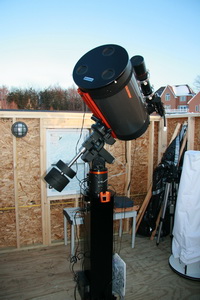
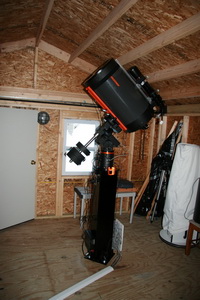 The
scope's home changed when my backyard observatory
was built in the summer of 2008 and the CGE1400 has been moved to its
permanent location.
The
scope's home changed when my backyard observatory
was built in the summer of 2008 and the CGE1400 has been moved to its
permanent location.
Until the summer of 2008 CGE1400 was both visual and imaging scope. With the 14" aperture the views are incredible, C9.25 or any other of my previous scopes could not compare. I spent lots of time just looking at old Messiers, and for a long time I was just rediscovering all the objects that were so familiar from the nights with C9.25. All the old stuff was like new now! I was lucky with my old CG-5 that it worked well, but CGE is an order of magnitude better (I never used CG-5 with the new version of the hand controller though). Without precise polar alignment it was always able to bring objects close to the middle FOV of 20mm Expanse eyepiece (0.34 deg), and at least to the edge of 15mm Expanse all the time. At the beginning I have measured the accuracy of pointing on a few examples, like on Struve 2308 (RA18:00.2 DEC+80:00 – it was the largest Dec on my list for this night) and the error was slightly less than ~10 arc min. On Cat's Eye Nebula (DEC+66:38) the error was smaller, ~5 arc min. I stopped doing 2+2 alignment soon - I was getting very good results with just 2 alignment stars, the mount remembers cone error and misalignments and they probably stay very similar from one observing session to another. And when I used to roll the telescope out of the shed I just marked the positions of the wheels so it ended up in similar orientation each time. Now that the scope sits in the observatory and I stopped doing even 2 star alignment - I just use "last alignment". When imaging at long focal length (f7 or f8) I usually use "precise GOTO" command, it requires a sync on a bright star in the neighborhood of the target, but then it always places the target object on the camera sensor with no problem.
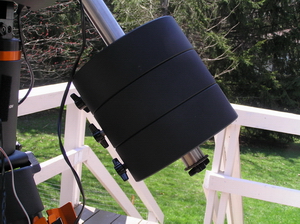
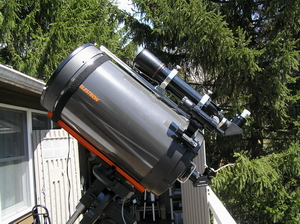 I have added Celestron
C80ED refractor on the top of C14 with Ken Millburn's dovetail bar and
rings. It is very useful finder scope as well as guiding scope for
imaging. In order to balance it's weight I had to add third full 22lb
counterweight.
I have added Celestron
C80ED refractor on the top of C14 with Ken Millburn's dovetail bar and
rings. It is very useful finder scope as well as guiding scope for
imaging. In order to balance it's weight I had to add third full 22lb
counterweight.
CGE1400 works very well for astrophotography - I used it with Canon Digital Rebel (XTi), then with Canon40D, CCD-Labs QHY8 and lastly with SBIG ST-8300M in various configurations. The payload of my setup is close to the maximum for CGE mount at about 58lb: 45lb C14 OTA, 8lb Celestron C80ED refractor and 5lb rings/dovetail. I asked Celestron if it is too much when I was about to buy it, and they answered that the maximum useful payload (NOT including counterweights) for CGE mount is 65lb. There are no problems with auto guided exposures of about 5 minutes at any focal length - see "Astrophotgraphy" section for images and "Imaging with CGE1400" for more details about imaging setup.
C14 does not require frequent collimation, even when used with Hyperstar from time to time. However, correct collimation is important, especially for planets and the Moon. There are many articles on SCT collimation, online (here or here) or in print (Rod Mollise "Choosing and Using a New CAT"). In practice, one usually has to do final C14 collimation on a slightly defocused star, in-focus diffraction rings are too small for an average seeing, but this level of accuracy is more than enough.
C14 does not require corrector cleaning almost at all. So far (October 2016) I have done it only twice to remove a layer of dust (inside and outside) that I wasn't able to blow away. If it is only dirty outside one can clean it without removing it from the OTA, otherwise it needs to be removed and cleaned on both sides. It is not difficult to do, but you have to be VERY careful at all times, and preserve the original corrector orientation / secondary centering. There are many good online articles about it, especially on C14 Yahoo group site.
OK, so now: have I had any problems with it? Yes, I have, but only a minor one: tripod legs locking screws. The original screws that are supposed to lock extended tripod legs in place are sloppy, and allow for slippage, my setup is more susceptible to this than average since with C14 and C80ED on the top if it I am pretty much at the weight limit for the mount. There are two simple solutions. You can get a regular screw from a hardware store and tighten it properly, but then you may dent your tripod leg and scratch the paint. The other is to use hose clamps and install them on the extended part of the leg – you still may scratch the paint. I applied both and no problems since! Before fixing screws I had to adjust level every time I rolled the scope out, this is how found the problem. I would strongly encourage new CGE1400 owners to address this problems since if you don't notice the slippage your tripod may get very uneven and then trip over ...
When CG1400 was my primary visual scope the most used eyepieces were: for wide field of view Orion Optiluxe 40mm and UWAN 28mm (82 AFOV); Orion Expanse 20mm and 15mm for middle field of view; then Tele-Vue Radian 10mm for higher magnifications. Sometimes, on exceptionally steady nights I used 2x Barlow on the planets and the Moon. The table below shows viewing parameters of the eyepieces I used at that time.
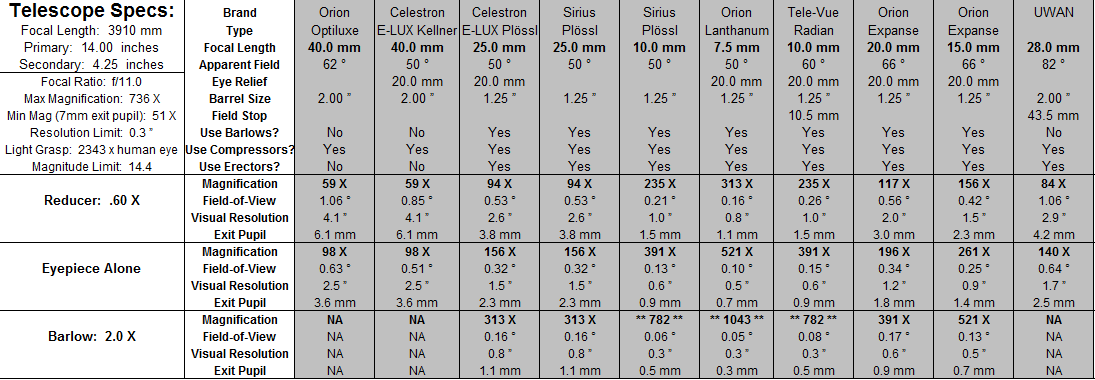
NOTE. 1.06 degree FOV in the table above is purely theoretical - using 0.6 reducer and 40mm eyepiece will result in severe vignetting. The widest field I used was 0.63º ...
There are two good discussion groups devoted to this hardware C14 Yahoo group and CGE Yahoo group, and an excellent general Schmidt-Cassegrain Yahoo group SCT-User with lots of more information.
